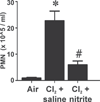Administration of nitrite after chlorine gas exposure prevents lung injury: effect of administration modality
- PMID: 22917977
- PMCID: PMC3448851
- DOI: 10.1016/j.freeradbiomed.2012.08.007
Administration of nitrite after chlorine gas exposure prevents lung injury: effect of administration modality
Abstract
Cl(2) gas toxicity is complex and occurs during and after exposure, leading to acute lung injury (ALI) and reactive airway syndrome (RAS). Moreover, Cl(2) exposure can occur in diverse situations encompassing mass casualty scenarios, highlighting the need for postexposure therapies that are efficacious and amenable to rapid and easy administration. In this study, we assessed the efficacy of a single dose of nitrite (1 mg/kg) to decrease ALI when administered to rats via intraperitoneal (ip) or intramuscular (im) injection 30 min after Cl(2) exposure. Exposure of rats to Cl(2) gas (400 ppm, 30 min) significantly increased ALI and caused RAS 6-24h postexposure as indexed by BAL sampling of lung surface protein and polymorphonucleocytes (PMNs) and increased airway resistance and elastance before and after methacholine challenge. Intraperitoneal nitrite decreased Cl(2)-dependent increases in BAL protein but not PMNs. In contrast im nitrite decreased BAL PMN levels without decreasing BAL protein in a xanthine oxidoreductase-dependent manner. Histological evaluation of airways 6h postexposure showed significant bronchial epithelium exfoliation and inflammatory injury in Cl(2)-exposed rats. Both ip and im nitrite improved airway histology compared to Cl(2) gas alone, but more coverage of the airway by cuboidal or columnar epithelium was observed with im compared to ip nitrite. Airways were rendered more sensitive to methacholine-induced resistance and elastance after Cl(2) gas exposure. Interestingly, im nitrite, but not ip nitrite, significantly decreased airway sensitivity to methacholine challenge. Further evaluation and comparison of im and ip therapy showed a twofold increase in circulating nitrite levels with the former, which was associated with reversal of post-Cl(2) exposure-dependent increases in circulating leukocytes. Halving the im nitrite dose resulted in no effect in PMN accumulation but significant reduction of BAL protein levels, indicating a distinct nitrite dose dependence for inhibition of Cl(2)-dependent lung permeability and inflammation. These data highlight the potential for nitrite as a postexposure therapeutic for Cl(2) gas-induced lung injury and also suggest that administration modality is a key consideration in nitrite therapeutics.
Copyright © 2012 Elsevier Inc. All rights reserved.
Conflict of interest statement
Figures







References
-
- Cevik Y, Onay M, Akmaz I, Sezigen S. Mass casualties from acute inhalation of chlorine gas. South Med J. 2009;102:1209–1213. - PubMed
-
- Evans RB. Chlorine: state of the art. Lung. 2005;183:151–167. - PubMed
-
- Matalon S, Maull EA. Understanding and treating chlorine-induced lung injury. Proceedings of the American Thoracic Society. 2010;7:253. - PubMed
Publication types
MeSH terms
Substances
Grants and funding
LinkOut - more resources
Full Text Sources

